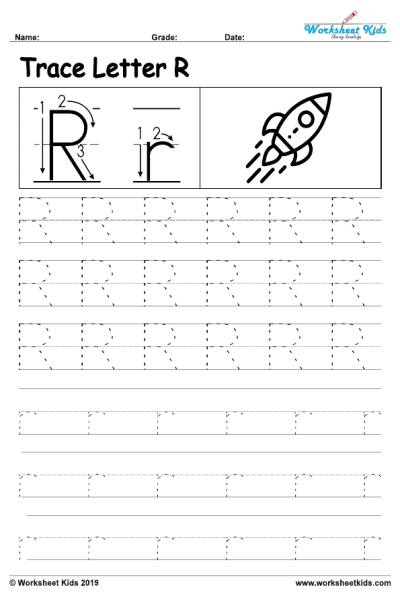As a teacher and parent, you understand the importance of providing engaging and effective resources to help your students and kids grasp essential math concepts. In elementary education, we often refer to grades 3, 4, and 5 as the foundation for developing advanced math skills. One crucial topic introduced at these levels is multiplication, where kids first encounter simple multiplication word problems.
This blog post offers an exhaustive guide on using free printable multiplication word problem worksheets suitable for 3rd-grade, 4th-grade, and 5th-grade learners. For the convenience of teachers, parents, and educators, these resources are available in a ready-to-print PDF format, strictly aligned with the Common Core standards. Let’s delve deeper.
Grade 3: Simple and Easy Multiplication Word Problems
In the early stages, specifically third grade, kids are introduced to single-digit multiplication word problems. These problems are designed to be simple and easy to comprehend. The emphasis is on helping the graders solve these problems and making them understand the concept.
For instance, a grade 3 problem might say, “Sam has 4 sets of stickers. Each set has 5 stickers. How many stickers does Sam have in all?” Here, the student can visualize the situation and solve the problem.



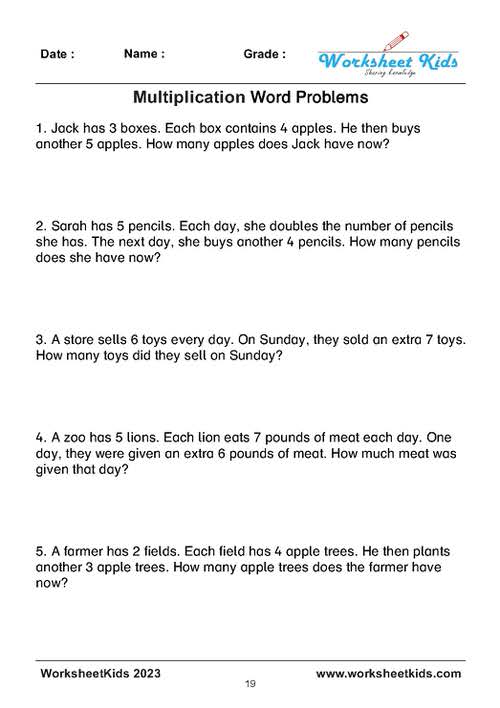
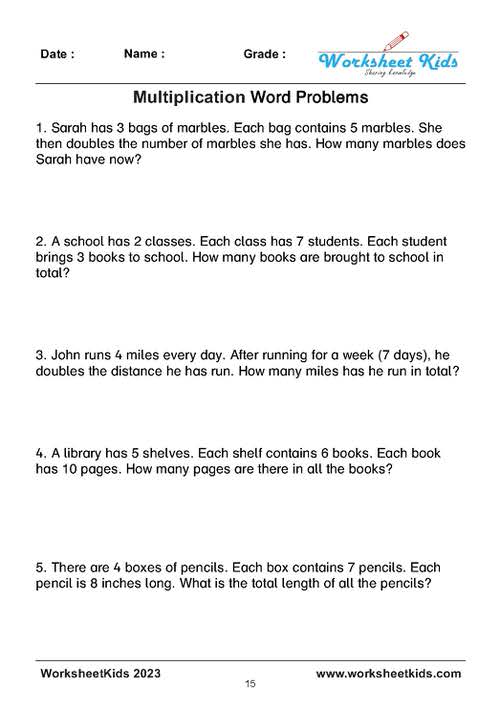
Grade 4: 2-Digit by 1-Digit Multiplication Word Problems
As the learners transition from 3rd to 4th grade, their mathematical understanding must be challenged and enriched. They are introduced to 2-digit by 1-digit multiplication word problems at this stage.
An example for 4th graders might be, “Sarah has 13 packs of candies. Each pack contains 6 candies. How many candies does Sarah have in total?” Such problems enhance their multiplication skills and provide insight into real-world scenarios.

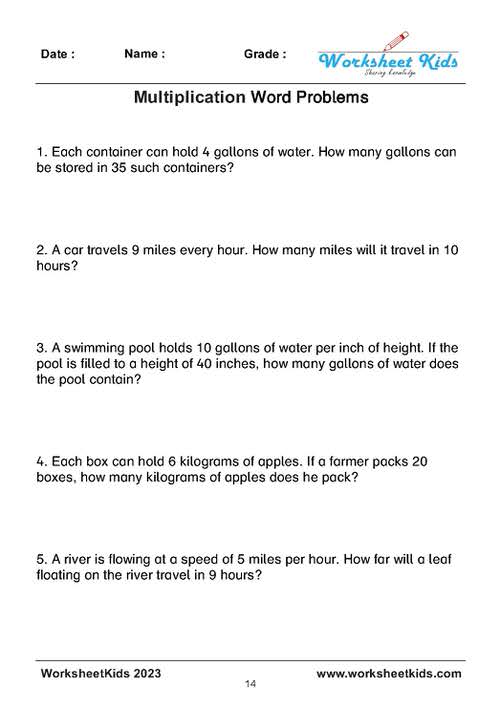


Grade 5: Addition and Subtraction with Multiple step Multiplication Mixed Problems
Combining operations helps students understand the relationships between them and develops their mental agility. This is where mixed addition with multiplication word problems and mixed subtraction with multiplication word problems come into the picture.
A typical 5th-grade problem could be, “A shopkeeper has 20 boxes of chocolates. Each box contains 12 chocolates. He sold 8 boxes. How many chocolates does he have left?” Here, students use both multiplication and subtraction to solve the problem.

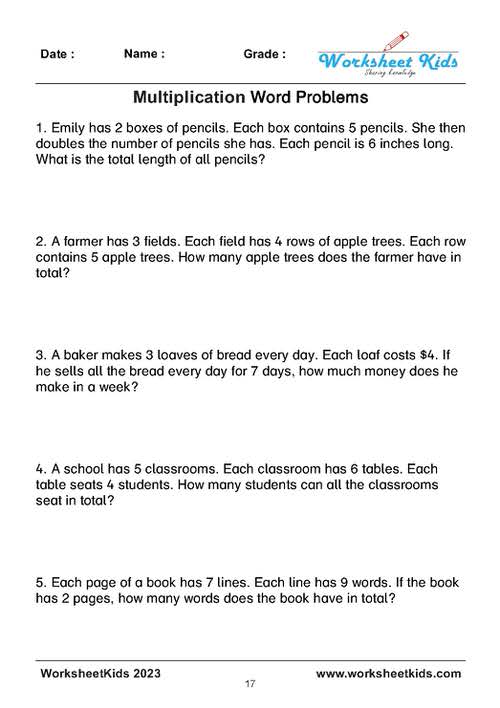



Taking the Challenge Head-On: 2-Digit by 2-Digit Multiplication Word Problems
When discussing fifth grade, we aim to provide the learners with complex and difficult multiplication word problems. These problems, such as the 2-digit by 2-digit multiplication word problems, often require multiple steps and higher-order thinking skills.
For example, “A factory produces 25 boxes daily, each containing 24 widgets. How many widgets are produced in a day?” Such questions challenge the students’ understanding of the multiplication process and their ability to apply it.


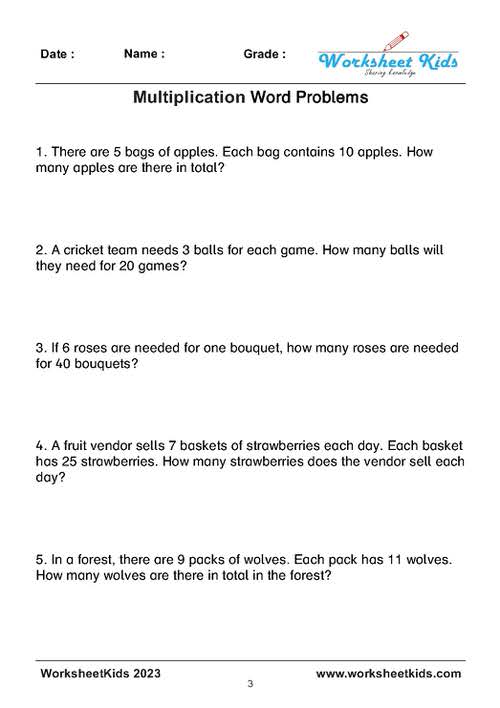

Practical Applications: Money and Measurements Involved Problems
Money-involved and measurements-involved multiplication word problems are incorporated into these worksheets to make the multiplication process more engaging and practical.
A money problem can be, “John bought 7 toys at $15 each. How much money did he spend?” A measurement problem could be, “A rectangular field has a length of 60 meters and a breadth of 40 meters. What is the area of the field?”
These real-world problems promote the application of multiplication in day-to-day life and make the learning process more relatable.




Practice Makes Perfect: Using Multiplication Word Problem Worksheets
We aim to ensure that the students get adequate practice with these problems. Our free printable worksheets include various multiplication word problems involving integers, multiple steps, and different types of numbers.
These worksheets have been designed keeping in mind the students’ evolving learning needs. They have a detailed answer key to assist teachers and parents in effective assessment and feedback.
To summarise, our multiplication word problem worksheets for grades 3, 4, and 5 aim to instill a love for numbers in young minds and build a strong foundation for future math skills. They provide an excellent resource for teachers to use in the classroom or as homework. After all, practice, when combined with understanding, leads to mastery.
Remember, every integer involved is an opportunity to learn. Let’s encourage our children to solve, practice, and conquer. Happy multiplying!

